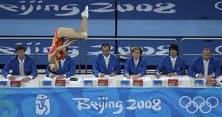Trampolining first became an Olympic sport at the Sydney Games in 2000 but European and World Championships have taken place on a regular basis since 1969. Initially, the Americans dominated the competitions but gradually the former USSR, Germany, France and Great Britain provided strong competition for the major prizes. In recent years Canada has also produced some Olympic medalists. Since first becoming an Olympic sport China has been successful in developing world-class trampolinists , culminating in winning the 2007 Men’s World Championship and both Men’s and Women’s gold medals and a bronze in the 2008 Olympic Games held in Beijing.
Men and women compete separately in individual events for trampoline competitions. In the qualifying rounds the entrants complete both optional and compulsory routines, whereas in the final round the contestants perform an optional routine only. The routines consist of combinations of 10 contacts with the trampoline mat which consist of varying rotations, twists and shapes with take-off and landing in one of four positions, being feet, seat, back and front. The whole routine must start and finish on the feet though.
The compulsory routine takes the form of a pre-set sequence of skills. The optional routine must contain 10 different moves which will normally be performed in one of the following 3 shapes: tucked (knees tucked up to the chest and clasped with the arms), straight (arms, legs and body straight) and piked (where hands are touching close to the feet with both arms and legs straight).
There is no time limit on each routine and only one attempt is allowed at each routine. The routine should end with the competitor in an upright position with both feet on the trampoline bed. They must remain upright for at least three seconds at the end of the routine.
The routine is given to the judges in advance on cards but the separate moves can be performed in any sequence. Most moves include twists and somersaults in a variety of forms. Each is given a degree of difficulty, the higher the difficulty the higher the score. The number of twists and somersaults in each move will count towards the difficulty rating.
A full somersault is worth 0.4 points, a quarter somersault is worth 0.1 points and a three-quarter somersault is worth 0.3 points. A full twist gets 0.2 points and a half twist gets 0.1 points. For a move involving both a twist and a somersault the scores are added together.
Two difficulty judges confer to give the difficulty score for each routine, normally in the range high 15s to low 16s for men and high 13s to high 14s for women. A panel of five judges assess the execution of each routine giving a score out of 10. For this they take account of form, consistent height and control, deducting fractions of points for faults. Fractions of points are deducted for errors in performance such as a break in form or an extra bounce. Style is also important. Judges will reward competitors who perform with artistry and grace. Execution of therefore weighted more heavily than difficulty in the final score.
The highest and lowest score for each routine from the five judges are discarded and the other three are totalled. To this is added the difficulty score giving a final score for the routine. If scores are tied then the two discarded scores are included to determine the winner.
I hope this article gives you more understanding of how the skill of a trampolinist is judged and will aid your enjoyment when watching future trampoline competitions.
Author: Bob Bounce
